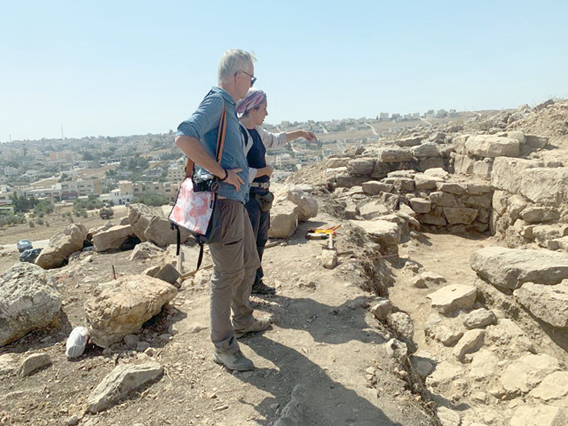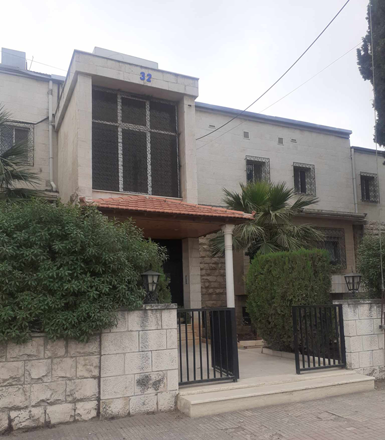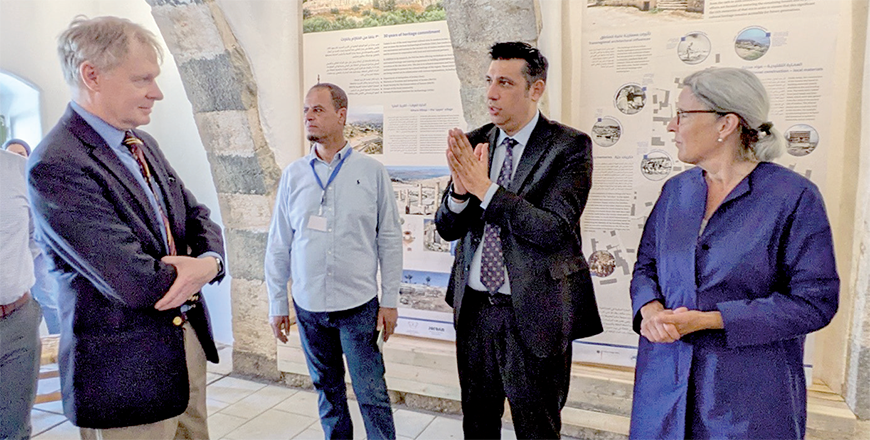You are here
Archaeological research a key facet of Jordan-Germany ties — scholar
By Saeb Rawashdeh - Oct 08,2023 - Last updated at Oct 08,2023

Tell Ushai’r/Kufr Youba near Irbid during the excavation with Free University Berlin on Friday (Photo courtesy of Zeidan Kafafi)
AMMAN — Since its establishment of a branch of the German Protestant Institute of Archaeology [GPIA] in Amman in 1975, the GPIA has developed into an active partner for many Jordanian institutions that conduct archaeological research, according to Professor Emeritus Zeidan Kafafi.
The Jordanian scholar’s remarks came on the sidelines of the celebration of the 70 years of the German-Jordanian diplomatic ties held last week in Amman.
A key reason that motivates scholars to research Jordanian archaeology is that they consider Jordan part of the Holy Land, Kafafi said.
The German Protestant Institute for Archaeology in the Holy Land was founded in Jerusalem in 1900, after the visit of Emperor William II, Kafafi continued.
The Amman branch was established with the financial help from the Volkswagen Foundation in Amman.
“Today the GPIA not only conducts its own excavations, but also functions as a partner for a number of German universities and institutions, such as the German Archaeological Institute (DAI), which do research in Jordan,” Kafafi said.
Since 1974, the GPIA has helped — in cooperation with the Department of Antiquities (DoA) of Jordan — to develop the classical site of “Gadara” (modern-day Umm Qais in northern Jordan) by conducting excavations, installing a local museum and restoring houses of the Ottoman period, the professor said.
In the mid-1980s the DAI and bit later the “Staatliche Museen zu Berlin” (National Museums of Berlin) joined the archaeological research in Gadara, he continued.
“During the last decades, the DAI, Tübingen University, the Free University of Berlin, the Kirchliche Hochschule Wuppertal and the Mining Museum Bochum started field projects at the sites of Khirbet ez-Zeiraqoun, Basta, Sal, Khanasri, Tell Zer’a, Johfiyyeh, Maqas, Hujeiret Ghuzlan, eh- Sayyeh, Tell Bleibel and Tell Ushai’er jointly with Yarmouk University and with the cooperation and support of the DoA. Furthermore, the GPIA and the DAI also intensified their activities in the country,” Kafafi noted.
Much field work is jointly carried out with the DoA and German universities and institutions.
“From these I may name the Balua excavations, the Wadi Faynan work on mining facilities and settlement remains, Petra and its vicinity, and so on,” Kafafi outlined.
As a result of these projects, joint publications, workshops and exchange of visits by technicians and students have occurred, he said.
Furthermore, Germany helped Jordan in developing archaeological sites such as Umm Qais and Petra for tourism purposes.
In addition, the Museum of Jordanian Heritage, established in 1988, and the Umm Qais Museum are the fruits of German Jordanian cooperation, Kafafi said, adding that much of the funding needed was provided by the German Foreign Office.
In recent decades, German archaeological museums have become very much interested in introducing the Jordanian archaeological heritage to Germans.
“Thus, temporary exhibitions were prepared jointly with the Jordanian institutions. For example, in 1987 the Rautenstrauch-Joest-Museum fuer Volkerkunde in Koeln arranged an archaeological exhibition about Jordanian heritage and was named as “Der Koenigsweg. 9000 Jahre Kunst und Kultur in Jordanien und Palaestina”.
On September 30, 2004, Klaus Burkhardt, the German ambassador to Jordan, announced that His Majesty King Abdullah together with the former German president Horst Koehler would open an archaeological exhibition named “Faces of the Orient” on October 7. The exhibition covered about 10,000 years of art and Jordanian culture in the Altes Museum in Berlin, Kafafi recalled.
“Last, but not least, Germany is helping Jordan by offering scholarships through the DAAD to Jordanian scholars to pursue their studies in Germany. Many Jordanian archaeologists have received their higher education or training in Germany. Also, I should not forget the Alexander von Humboldt-Stiftung foundation, which helped Jordanian scholars conduct research at German institutions,” Kafafi concluded.
Related Articles
AMMAN — German intellectual presence in the southern Levant dates back to the late 18th early 19th century when the first orientalists, hist
AMMAN — Germany’s intellectual curiosity about the holy land dates back to the arrival of German orientalists in the early 19th century, and
AMMAN — After years of joint efforts between the Department of Antiquities (DoA) and the German Archaeological Institute in Berlin (DAI), th













